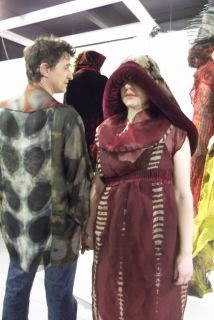La Primavera and the silk worms are frenetic....
Visiting the
Sericulture Centre
Padova , a city of Veneto,
that has a Sericulture research
where you can see at first hand the specially humidified
rooms which house trays of burgeoning
silkworms. We will visit when
the silkworms grow to their maximum
size. At that stage they have
voracious appetites and the sound of
them munching accompanies their frenzied growth cycle that
needs constant sustenance...
needs constant sustenance...
The Stazione Bacologica Sperimentale,
in which silkworm eggs are available
each year to interested silkworm
like me. It was founded in 1871
by a decree of Vittorio Emanuele II,
though the actual founder was Enrico
Verson. It is a section of the Institute
TEXERE Newsletter Spring 2011
for the Experimental Agrarian Zoology
of Florence. The current director is Dr.
Luciano Cappellozza and the Institute
building is owned by the Provincial
Administration of Padua, which has
developed a museum with live collections
of insects. This includes exhibitions
on sericulture, apiculture and a
general display of Lepidoptera. The
sericulture part shows the silk collections
of the section as well as old tools
and machines used for the rearing of
the silkworms and the reeling of the
cocoon, which is ideal fo children
to obtain first hand experience of
these processes.
The institute is involved in scientific
projects on sericulture and moriculture
and contributes to the conservation
of two germplasm banks of about
50 varieties of Morus spp and about
120 strains of Bombyx mori. The institution
owns a mulberry field, also
used for experiments, that provides
the leaves necessary for the rearing
and breeding of the various Bombyx
strains.
Italy has been one of the main centres
of silk production in the world
since the 13th century and was third
in importance after China and Japan.
The Como region of Italy has always
been the main centre of silk production,
but the Veneto area has also
times the Venetian traders flourished
from the production and trading
of silk cloth. The sericulture industry
was still a vital moneymaking practice
for the farm people in Veneto a
century ago. There was an Octogenarian
who struck up a conversation
when they saw us gathering mulberry
leaves who remembered the small
lean-tos attached to the houses where
silkworms were reared, a room of
their own - needing warmth at night
to survive.
The variety of colours of the cocoons
which are genetic variants of bombyx
mori is remarkable and not due to
feeding the creatures different leaves
(see photo). The frequency of groves
of mulberry trees in Northern Italy is
the only indication these days of the
silk-rearing industry which provided
income a hundred years ago thanks
to the industrious and short lived life
cycle of Bombyx whose cocoons were
consigned to Como where industrial
mills produced silk for ties, clothing
and scarves for the middle classes.
Another use was silk for upholstery
and jacquards which are still being
woven at Fondazione Lisio (www.fondazionelisio.




